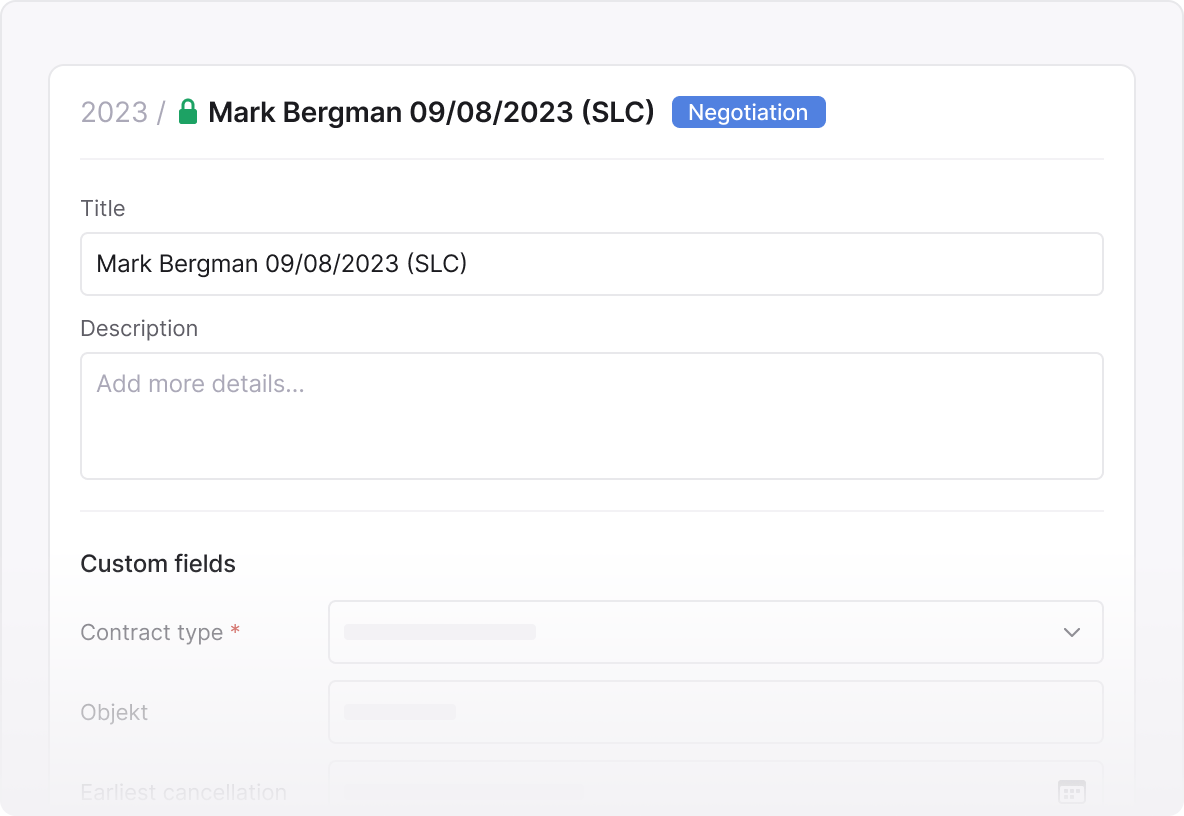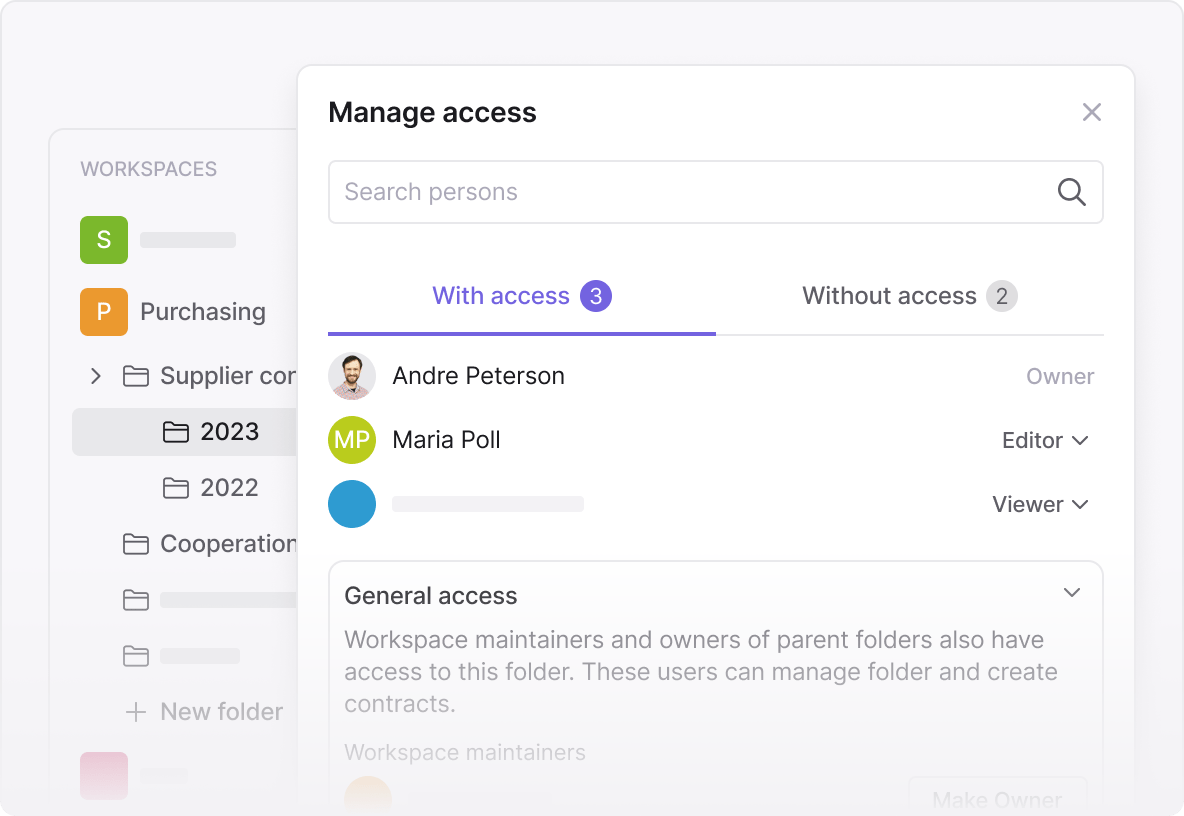Contract management software and eSignature
Create, sign and store contracts securely. Automated document analysis by AI and deadline control. Free digital signature.
Request a demo
Trusted by over 8000 happy users





Top features
Everything for successful contract management
Inhubber brings together all the tools you need for storage, digital signatures, analysis, search, approval and more.
Secure cloud storage
Secure cloud storage thanks to blockchain technology. There is end-to-end encryption of every contracts stored on our platform. The two-factor authentication provides
maximum security of your data.
Digital signature
of any file formats
of any file formats
Inhubber unique digital signature can sign any file formats like PDF, Word, Excel, MP4, JPEG, Zip and more without having to save the documents as PDF.
AI document analysis
Inhubber's Artificial Intelligence analyses your documents, highlighting only the important information and turning it into contextual contract data.
Deadline notification
Get alerts every time an important deadline is coming up.
Enterprise-level Collaboration
Create workspaces and folders with permissioning capability. Organize your contracts and decide who should have access to which documents.
Reporting & Dashboard
Get an overview of the most relevant information regarding your contracts with instant reporting capabilities.
Solutions
Built for all types of teams and industries
Real estate
Retail
Healthcare
Education
Public Sector

Stay organized by centralizing all of your contracts in one place
- Improve organization and visibility of your contracts
- Increase efficiency in your day to day operations
- Avoid potential liabilities and protect against legal disputes

Identify potential cost savings and minimize risks
- Establish stronger relationships with your suppliers
- Increase operational efficiency
- Reduce the risk of contract violations and penalties

Sleep calm knowing your contracts are safe
- Ensure privacy and security around your contracts
- Be compliant with federal regulations
- Increase efficiency and productivity

Solve numerous challenges within your contract management
- Keep track of intellectual property agreements
- Follow agreements with general service providers
- Better manage your contracts and eliminate bottlenecks

Identify and minimize potential risks
- Risk minimisation
- Cost savings
- Legal and regulatory compliance
Up to
0%
savings in total annual income
Save your total annual income with effective contract management.
Up to
0%
faster contracting
Save time signing contracts with digital signatures.
Up to
0%
reduction management costs
Save money on the annual cost of managing your contracts.
The International Association for Contract & Commercial Management.
Customer stories
"Powerfully simple"
Our clients love how easy it is to manage contracts and improve the efficiency of their business.
Award winning CLM software
Inhubber is recognized as one of the best Contract Lifecycle Management tools.






FAQ
Can't find the answers to your questions?
Contact sales →
What does Inhubber specialize in?
Inhubber specializes in the efficient and secure management of company contracts. Our solution allows for centralized storage of contracts with customizable access rights to prevent unauthorized access. Our platform supports procurement, sales, and HR by providing optimal contract management, keeping all key obligations, deadlines, and conditions in focus. Inhubber facilitates management with legally binding digital signatures and meets audit requirements, ensuring you can always respond quickly and efficiently to inquiries.
The challenges of modern contract management
Modern contract management poses several challenges for companies, which we categorize into six main areas. These define the requirements for the management process and highlight the benefits of our digital solution:
How does Inhubber leverage AI?
Inhubber uses advanced AI technologies to optimize your contract management:
With Inhubber's AI-based software, you stay informed and can respond quickly and efficiently to all contract-related matters.
The challenges of modern contract management
Modern contract management poses several challenges for companies, which we categorize into six main areas. These define the requirements for the management process and highlight the benefits of our digital solution:
- Centralized storage: All contracts in one place.
- Access rights: Customizable to prevent unauthorized access.
- Efficiency: Support for procurement, sales, and HR.
- Digital signatures: Legality and security.
- Audit requirements: Compliance with all legal standards.
- Staying informed: Always up-to-date on contract status.
How does Inhubber leverage AI?
Inhubber uses advanced AI technologies to optimize your contract management:
- Intelligent data analysis: Our AI scans your contracts and extracts relevant information, providing you with a quick overview of obligations, deadlines, and conditions.
- Automatic notifications: You receive timely reminders of important dates and deadlines, ensuring you never miss a commitment.
- Search function: Find relevant contract information in seconds with our powerful AI-driven search feature.
With Inhubber's AI-based software, you stay informed and can respond quickly and efficiently to all contract-related matters.
Does Inhubber have a dynamic contract repository with clearly defined access rights?
Inhubber's Contract Storage
Searching for the Right Contract Document
An optimal contract management system follows, like all other business processes, a clear objective: efficiency! The goal is to use resources sustainably, regardless of the business area. In the context of efficient contract management, this resource is primarily time! If an employee spends 30 minutes a day searching for the right contract, this inefficiency sums up to 15 working days over a year. Time lost searching for the right document. With a large number of employees, this quickly adds up, resulting in one main thing: costs!
Accessing Contract Documents
Efficiency is also crucial when it comes to accessing contract documents. With decentralized contract storage, contracts are not readily available for quick and targeted access. Employees from other departments and those working in the field are equally affected. Here again, the critical resource is time!
In the contract storage, all contracts of a company are collected. Contracts can be stored specifically according to requirements and provided with appropriate access rights. This way, the needed contract can not only be found quickly in case of need but also accessed from anywhere in the world. All that is needed is an internet connection. With contract storage, processes can be designed to be efficient and secure, ensuring that contracts are available when needed.
Searching for the Right Contract Document
An optimal contract management system follows, like all other business processes, a clear objective: efficiency! The goal is to use resources sustainably, regardless of the business area. In the context of efficient contract management, this resource is primarily time! If an employee spends 30 minutes a day searching for the right contract, this inefficiency sums up to 15 working days over a year. Time lost searching for the right document. With a large number of employees, this quickly adds up, resulting in one main thing: costs!
Accessing Contract Documents
Efficiency is also crucial when it comes to accessing contract documents. With decentralized contract storage, contracts are not readily available for quick and targeted access. Employees from other departments and those working in the field are equally affected. Here again, the critical resource is time!
In the contract storage, all contracts of a company are collected. Contracts can be stored specifically according to requirements and provided with appropriate access rights. This way, the needed contract can not only be found quickly in case of need but also accessed from anywhere in the world. All that is needed is an internet connection. With contract storage, processes can be designed to be efficient and secure, ensuring that contracts are available when needed.
Can several people sign the contract digitally via the Inhubber platform?
Signature Management
Contract Signing with Multiple Parties
Decentralized and non-digital management of contract documents means that contracts must be sent back and forth for signatures or parties must meet in person to sign. This process increases the consumption of a key resource: time! Since time is always a cost factor, an increased time factor inevitably leads to higher costs, which can be avoided.
The keyword here is: Digital Signature. It saves time and shortens the span between contractual agreements and the signing of the contract. Digital signatures are of particular interest in the real estate industry. Given the multitude of contracts typical in this sector, the traditional method of "printing, signing, and scanning" is not only antiquated but also cumbersome.
Meeting the Requirements
The use of digital signatures is bound by legal requirements. For fixed-term leases, a simple or advanced digital signature is permissible, while the law requires a qualified electronic signature for contracts with graduated rent. With Inhubber, contracts and attachments can be processed digitally in a convenient and legally secure manner. This not only conserves the environment but also saves a crucial resource: time! Have your lease agreements signed digitally! Inhubber's digital contract management makes this possible.
Contract Signing with Multiple Parties
Decentralized and non-digital management of contract documents means that contracts must be sent back and forth for signatures or parties must meet in person to sign. This process increases the consumption of a key resource: time! Since time is always a cost factor, an increased time factor inevitably leads to higher costs, which can be avoided.
The keyword here is: Digital Signature. It saves time and shortens the span between contractual agreements and the signing of the contract. Digital signatures are of particular interest in the real estate industry. Given the multitude of contracts typical in this sector, the traditional method of "printing, signing, and scanning" is not only antiquated but also cumbersome.
Meeting the Requirements
The use of digital signatures is bound by legal requirements. For fixed-term leases, a simple or advanced digital signature is permissible, while the law requires a qualified electronic signature for contracts with graduated rent. With Inhubber, contracts and attachments can be processed digitally in a convenient and legally secure manner. This not only conserves the environment but also saves a crucial resource: time! Have your lease agreements signed digitally! Inhubber's digital contract management makes this possible.
Is Inhubber compliant with the GDPR?
Yes, Inhubber is fully compliant with the General Data Protection Regulation (GDPR). We have implemented extensive measures to ensure that all personal data processed in our systems meets the highest standards of security and data protection. Our platform offers features such as end-to-end encryption and detailed access rights to ensure the protection of your data. For more information, please visit our Security page.
Security and Data Protection
Legal requirements play a crucial role in contract management. In particular, data protection requirements must be strictly observed, as violations of data protection regulations can result in costly fines. Many companies are also subject to statutory retention obligations, which must be adhered to. This is almost impossible with decentralized contract management, as each department and colleague maintains their own method of filing and archiving. Inhubber's digital contract management helps implement a unified approach and significantly reduces errors by centrally managing all contract data within the company.
Whenever sensitive data is involved, questions of data security and protection arise. Especially with the digital processing of contracts, which contain a large amount of highly sensitive personal data, this topic is essential for trustworthy collaboration with customers and business partners. Regarding a planned certification, the area of data security is of great importance. Failure to meet data protection requirements is directly opposed to certification and thus prevents the successful completion of the certification process.
Security and Data Protection
Legal requirements play a crucial role in contract management. In particular, data protection requirements must be strictly observed, as violations of data protection regulations can result in costly fines. Many companies are also subject to statutory retention obligations, which must be adhered to. This is almost impossible with decentralized contract management, as each department and colleague maintains their own method of filing and archiving. Inhubber's digital contract management helps implement a unified approach and significantly reduces errors by centrally managing all contract data within the company.
Whenever sensitive data is involved, questions of data security and protection arise. Especially with the digital processing of contracts, which contain a large amount of highly sensitive personal data, this topic is essential for trustworthy collaboration with customers and business partners. Regarding a planned certification, the area of data security is of great importance. Failure to meet data protection requirements is directly opposed to certification and thus prevents the successful completion of the certification process.
Is Inhubber a cloud-based application?
The Cloud as a Secure Data Storage
The Error-Prone Nature of Decentralized Contract Management
Companies evolve, expand, and grow. Consequently, the number of contracts signed increases, which also applies to the versions of each contract. Here, the version history of digital contract management is crucial for significantly reducing error rates. As each version progresses, the potential for errors increases if contract management is decentralized and analog. This consumes a considerable amount of time, thus significantly raising cost risks. In this area, Inhubber’s centralized, digital, and cross-departmental management of contract data helps eliminate error sources and, most importantly, save costs.
Security through Cloud Storage
Various providers of cloud storage solutions have gained increasing importance in recent years. Inhubber is no exception in this regard. However, what sets us apart is the end-to-end encryption of data when using Inhubber. You can be confident that data is encrypted from user to user, ensuring the protection of stored contract data at all times. Digitizing contracts becomes not only secure but also remarkably easy! The era of Excel contract management is over.
Through our innovative cloud system, Inhubber helps you securely store your contracts and all related documents in the cloud. You can share contract passages, define access permissions, and easily specify who can access which contract data and when. This way, you can guarantee your partners absolute security for the data stored with us. Additionally, our cloud servers are ISO 27001 certified and thus GDPR compliant.
The Error-Prone Nature of Decentralized Contract Management
Companies evolve, expand, and grow. Consequently, the number of contracts signed increases, which also applies to the versions of each contract. Here, the version history of digital contract management is crucial for significantly reducing error rates. As each version progresses, the potential for errors increases if contract management is decentralized and analog. This consumes a considerable amount of time, thus significantly raising cost risks. In this area, Inhubber’s centralized, digital, and cross-departmental management of contract data helps eliminate error sources and, most importantly, save costs.
Security through Cloud Storage
Various providers of cloud storage solutions have gained increasing importance in recent years. Inhubber is no exception in this regard. However, what sets us apart is the end-to-end encryption of data when using Inhubber. You can be confident that data is encrypted from user to user, ensuring the protection of stored contract data at all times. Digitizing contracts becomes not only secure but also remarkably easy! The era of Excel contract management is over.
Through our innovative cloud system, Inhubber helps you securely store your contracts and all related documents in the cloud. You can share contract passages, define access permissions, and easily specify who can access which contract data and when. This way, you can guarantee your partners absolute security for the data stored with us. Additionally, our cloud servers are ISO 27001 certified and thus GDPR compliant.
How does blockchain technology ensure data security?
Data Security through Blockchain Technology
Due to its immutability, blockchain technology is the ideal way to maintain a trustworthy record and protect your data. The Inhubber blockchain logs all transactions and actions related to the stored documents and processes. Linked with a timestamp and confirmed by the identity of the author, it provides a clear trace of when any changes were made to a contract.
Addressing data protection concerns related to privacy and the deletion issue of blockchain under GDPR, the Inhubber blockchain contains no original data, only their "fingerprints". This ensures that the original data remains protected, and only their checksums are stored on the blockchain, guaranteeing maximum security and GDPR compliance.
Due to its immutability, blockchain technology is the ideal way to maintain a trustworthy record and protect your data. The Inhubber blockchain logs all transactions and actions related to the stored documents and processes. Linked with a timestamp and confirmed by the identity of the author, it provides a clear trace of when any changes were made to a contract.
Addressing data protection concerns related to privacy and the deletion issue of blockchain under GDPR, the Inhubber blockchain contains no original data, only their "fingerprints". This ensures that the original data remains protected, and only their checksums are stored on the blockchain, guaranteeing maximum security and GDPR compliance.
Does Inhubber ensure that events and deadlines are easily tracked and can no longer be missed?
Data Analysis
Deadlines and Deadline Management
Errors in the area of deadline management are often very costly. Mistakes in deadline management immediately impact costs and must be avoided. Overlaps of contracts to be terminated with already initiated tenders can quickly lead to double cost burdens if, for example, the termination deadlines of old contracts are missed, thereby extending the duration of the corresponding contract. With Inhubber's digital contract management and its integrated deadline control, errors can be avoided and additional costs significantly reduced.
Inhubber's contract management not only provides a central place for storing contract data but also analyzes the key information of stored contracts within seconds. The ever-advancing technology of Artificial Intelligence (AI) offers significant possibilities that are continuously being developed and will fully automate many analysis processes in the near future. This way, deadlines can be monitored, compliance with contractual regulations can be tracked, and Inhubber helps you ensure that no essential information is overlooked. You can always focus on the most important part of your work: your customers!
With Inhubber, inquiries can be answered promptly without long searches. Interaction with customers comes to the forefront, and time-consuming research becomes a thing of the past. Especially in cross-departmental collaboration, centralized and digital contract management is a decisive advantage and conserves company resources.
Deadlines and Deadline Management
Errors in the area of deadline management are often very costly. Mistakes in deadline management immediately impact costs and must be avoided. Overlaps of contracts to be terminated with already initiated tenders can quickly lead to double cost burdens if, for example, the termination deadlines of old contracts are missed, thereby extending the duration of the corresponding contract. With Inhubber's digital contract management and its integrated deadline control, errors can be avoided and additional costs significantly reduced.
Inhubber's contract management not only provides a central place for storing contract data but also analyzes the key information of stored contracts within seconds. The ever-advancing technology of Artificial Intelligence (AI) offers significant possibilities that are continuously being developed and will fully automate many analysis processes in the near future. This way, deadlines can be monitored, compliance with contractual regulations can be tracked, and Inhubber helps you ensure that no essential information is overlooked. You can always focus on the most important part of your work: your customers!
With Inhubber, inquiries can be answered promptly without long searches. Interaction with customers comes to the forefront, and time-consuming research becomes a thing of the past. Especially in cross-departmental collaboration, centralized and digital contract management is a decisive advantage and conserves company resources.
Can a lean workflow be set up with Inhubber?
Designing Workflows
With Inhubber, workflows can be tailored to the specific needs of a company. Processes can be developed to specify which participants should sign or approve documents and when. This ensures that system processes are followed without the need for complex controlling mechanisms. The workflow dictates the process and ensures that the necessary contract data is available whenever needed. This allows companies to work more efficiently and focus on their core tasks.
With Inhubber, workflows can be tailored to the specific needs of a company. Processes can be developed to specify which participants should sign or approve documents and when. This ensures that system processes are followed without the need for complex controlling mechanisms. The workflow dictates the process and ensures that the necessary contract data is available whenever needed. This allows companies to work more efficiently and focus on their core tasks.
What are the benefits of using Inhubber in my company?
Inhubber as an advantage for companies
The benefits of using Inhubber as a fully digital document and management solution for automating contract management are numerous and clear.
Inhubber is the complete and comprehensive digital document and management solution for contract management. It includes integrated e-signature capabilities and the incorporation of AI solutions for comprehensive analysis of stored data.
Secure your advantage in daily contract processes and conserve your most important resources: your employees!
With Inhubber, you have the complete solution for secure collaboration, contract management, contract analysis, and tracking. This saves time and costs, which are crucial for the sustainable development of your company. Be convinced by the advantages of Inhubber and implement your personal complete solution for managing contract data. Customize Inhubber to your personal needs and benefit from our development experience. The flexibility of the system is your advantage in daily work.
Contact us and schedule an appointment with our experts. We will analyze the needs of your company and develop an individual solution tailored to your needs. Use our demo system to experience the advantages of digital contract management, digital signature system, and contract analysis in practice.
The benefits of using Inhubber as a fully digital document and management solution for automating contract management are numerous and clear.
- Time Savings: With Inhubber, you can access your contract data from anywhere in the world at any time. The tedious search through filing cabinets and folders is eliminated, saving valuable work time.
- Optimized Collaboration: Inhubber’s digital platform facilitates collaboration among all participants. Everyone involved in the process can easily access the needed data, increasing efficiency and productivity.
- Increased Security: Inhubber ensures that your data is secure from unauthorized access at all times. The platform provides detailed access rights management, which is GDPR-compliant and meets the highest security standards.
- Automated Deadline Management: Inhubber automatically monitors all relevant deadlines and reminds you of important dates in a timely manner. This helps avoid costly mistakes and contract extensions due to missed deadlines.
- Integrated eSignature Function: With Inhubber, contracts can be signed electronically and legally binding. This speeds up the contract signing process and significantly reduces paper usage.
- Artificial Intelligence for Data Analysis: Inhubber’s AI-based analysis tools allow for quick and precise evaluation of your contract data. This provides valuable insights and enables informed decision-making.
- Flexibility and Mobility: Whether working from home, in the field, or in the office – with Inhubber, you always have access to your contract data. This supports a modern and flexible work style.
- Environmental Friendliness: By digitizing contract management, you reduce paper consumption and actively contribute to environmental protection.
Inhubber is the complete and comprehensive digital document and management solution for contract management. It includes integrated e-signature capabilities and the incorporation of AI solutions for comprehensive analysis of stored data.
Secure your advantage in daily contract processes and conserve your most important resources: your employees!
With Inhubber, you have the complete solution for secure collaboration, contract management, contract analysis, and tracking. This saves time and costs, which are crucial for the sustainable development of your company. Be convinced by the advantages of Inhubber and implement your personal complete solution for managing contract data. Customize Inhubber to your personal needs and benefit from our development experience. The flexibility of the system is your advantage in daily work.
Contact us and schedule an appointment with our experts. We will analyze the needs of your company and develop an individual solution tailored to your needs. Use our demo system to experience the advantages of digital contract management, digital signature system, and contract analysis in practice.
Does Inhubber support all types of documents?
Yes – Inhubber supports all types of business documents across departments and use cases.
From supplier contracts and employment agreements to NDAs, onboarding forms, invoices, and compliance documents – Inhubber can handle them all. Our AI automatically identifies key clauses, dates, and obligations, making your documents searchable, structured, and legally secure.
From supplier contracts and employment agreements to NDAs, onboarding forms, invoices, and compliance documents – Inhubber can handle them all. Our AI automatically identifies key clauses, dates, and obligations, making your documents searchable, structured, and legally secure.
Can Inhubber work with all file types?
Yes – Inhubber supports all common file formats, not just PDFs.
You can upload, sign, and manage Word, Excel, images, videos, ZIP files, and even scanned documents — without converting them. All files are securely stored, searchable (thanks to OCR and AI), and fully integrated into your workflows.
You can upload, sign, and manage Word, Excel, images, videos, ZIP files, and even scanned documents — without converting them. All files are securely stored, searchable (thanks to OCR and AI), and fully integrated into your workflows.
Can Inhubber's AI analyze contracts and documents in different languages?
Yes. Our AI recognizes and analyzes contracts in any language – whether they are written in German, English, French, or others. It automatically extracts key contract data, deadlines, risks, and clauses without the need for prior translation. This ensures that you stay in control of your international documents – reliably, quickly, and across multiple languages.














